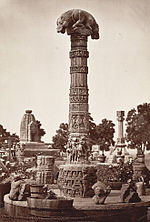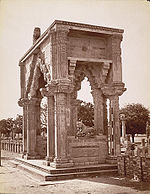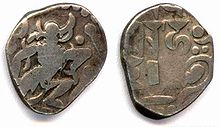- Mihira Bhoja I
-
Mihira Bhoja I 
Statue of Samraat Mihir Bhoj in the Bharat Upvan (Garden of India) of Akshardham Mandir, New Delhi. Reign 836–885 CE. Occupation Ruler of the Gurjara Pratihara Empire Religion Hinduism Mihira Bhoja I (836–885 CE) or Bhoja I was a ruler of the Gurjara Pratihara dynasty of India. He succeeded his father Ramabhadra. Bhoja was a devotee of Vishnu and adopted the title of Adivaraha which is inscribed on some of his coins.[1] One of the outstanding political figures of India in ninth century, he ranks with Dhruva Dharavarsha and Dharmapala as a great general and empire builder.[2]
At its height, Bhoja's empire extended to Narmada River in the South, Sutlej River in the northwest, and up to Bengal in the east. It extended over a large area from the foot of the Himalayas up to the river Narmada and included the present district of Etawah in Uttar Pradesh.[3]
Contents
Reign
When Mihira Bhoja started his career reverses and defeats suffered by his father Ramabhadra had considerably lowered the prestige of the Royal Gurjar Pratihar family. He invaded the Pala Empire of Bengal, but was defeated by Devapala.[4] He then launched a campaign to conquer the territories to the south of his empire and was successful. He gradually rebuilt the empire by conquest of territories in Rajasthan, Gujarat and Madhya Pradesh. The Chandelas of Bundelkhand acknowledged his suzerainty.[4] Besides being a conqueror, Bhoja was a great diplomat.[5] During his reign, the capital was in Kannauj (present-day Uttar Pradesh), during his period Kannauj was referred as Panchala.
He was a bitter enemy of the Muslim invasions[4] who, according to an Arab chronicler, Sulaiman, maintained a large army and had a fine cavalry.[6] The territories under his rule were prosperous and safe from robbers. His state was rich in natural resources, especially gold and silver mines.[7]
Many temples made by him still survive. Teli Mandir, near Gwalior, Madhya Pradesh, marks the presence of Vishnu on earth. The temple's architecture, design and layout features an outstanding fusion of architectural styles: the roof resembles a Dravidian style while the decoration highlights the art of North India.[8][9] He was a scholar and respected learned persons. Raj Shekhar was his court poet.
Bhoja had the reputation of a strong ruler, able to maintain peace in his empire and defend it and to make this task a sacred legacy to his succession. He was succeeded by his son Mahenderpal 1 (c.890 - 910 CE).
Mihira Bhoja finds a mention in the Daulatpura copper plate.
Coins of Mihira Bhoja I
Mihira Bhoja I's epithet was Srimad-Adivaraha (the fortunate primeval boar incarnation of Vishnu) and therefore there is a broad agreement amongst the scholars on the attribution of adivaraha dramma billon coins to him. These coins have a depiction of Adivaraha on the obverse.[10]
Adivaraha, the boar incarnation of Vishnu, wears a long "Vanamala" to right with his left leg raised. Below is a small lion, to the right a sun-wheel (chakra) symbol, a moon symbol and another dumb-bell-like symbol is above and a trident and conch shell on the left and a two-lined inscription Shrimad Adi Varaha, with traces of a stylised fire-altar and two female attendants.
Notes
- ^ Satish Chandra, National Council of Educational Research and Training (India) (1978). Medieval India: a textbook for classes XI-XII, Part 1. National Council of Educational Research and Training. p. 9. http://books.google.co.in/books?cd=7&id=tHVDAAAAYAAJ&dq=adivaraha+mihir+bhoj&q=adivaraha#search_anchor.
- ^ Radhey Shyam Chaurasia (2002). History of Ancient India: Earliest Times to 1000 A. D.. Atlantic Publishers & Distributors. p. 207. ISBN 812690027X,ISBN 9788126900275. http://books.google.co.in/books?id=cWmsQQ2smXIC&pg=PA207&dq. "He was undoubtedly one of the outstanding political figures of India in ninth century and ranks with Dhruva and Dharmapala as a great general and empire builder."
- ^ E-gazeteer-History of Etawah district
- ^ a b c Radhey Shyam Chaurasia (2002). History of Ancient India: Earliest Times to 1000 A. D.. Atlantic Publishers & Distributors. p. 207. ISBN 9788126900275.
- ^ Radhey Shyam Chaurasia (2002). History of Ancient India: Earliest Times to 1000 A. D.. Atlantic Publishers & Distributors. p. 207. ISBN 812690027X,ISBN 9788126900275. http://books.google.co.in/books?id=cWmsQQ2smXIC&pg=PA207&dq. "Besides being a conqueor, Bhoja was a great diplomat..."
- ^ Radhey Shyam Chaurasia (2002). History of Ancient India: Earliest Times to 1000 A. D.. Atlantic Publishers & Distributors. p. 207. ISBN 812690027X,ISBN 9788126900275. http://books.google.co.in/books?id=cWmsQQ2smXIC&pg=PA207&dq. "The king of Gurjars maintain numerous faces and no other Indian prince has so fine a cavalry."
- ^ Mahajan 1960, p. 644
- ^ "Places to visit in Gwalior, Teli ka mandir section". http://www.gwaliorhotels.net.in/places_to_see_in_gwalior.html.
- ^ "Monuments in Gwalior (Madhya Pradesh)". http://www.allindiatravelsinfo.com/monuments/monuments-in-gwalior.html.
- ^ Deyell 1999, pp. 28–29
References
- Deyell, John S. (1999), Living without Silver, Oxford University Press, New Delhi, ISBN 0 19 564983 4
- Mahajan, V.D. (1960, Reprint 2007), Ancient India, S. Chand & Company, New Delhi, ISBN 81-219-0887-6
Preceded by
Ramabhadra (833–836)Gurjara Pratihara Emperor
836–885 CESucceeded by
Mahendrapala ICategories:- Gurjar
- 836 births
- 885 deaths
- Rajput era
- Indian monarchs
- People from Kannauj
Wikimedia Foundation. 2010.



